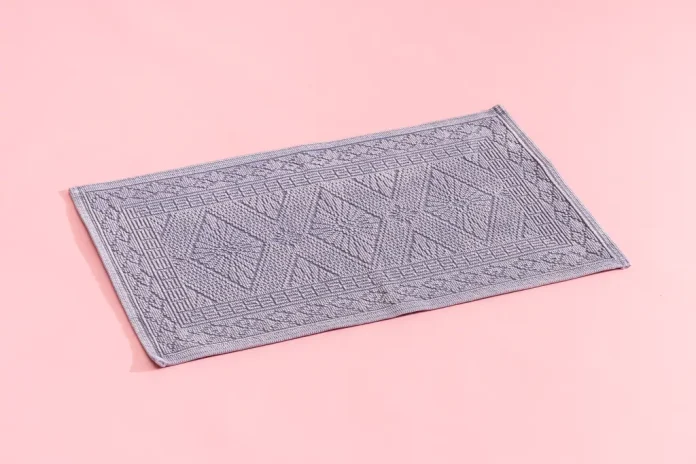Traditional rubber-backed bathroom rugs often create problems like slipping, unpleasant odors, and difficulty cleaning. Many homeowners face issues with rugs that leave sticky residue, trap moisture underneath, or simply don’t fit well in their bathroom spaces.
Bathroom rugs without rubber backing offer superior safety, easier maintenance, and better versatility while providing the comfort and water absorption needed in any bathroom. These alternatives use innovative materials and design features that eliminate common rubber backing problems while maintaining the functionality people expect from quality bath mats.
Modern bathroom rugs without rubber backing come in various materials and styles that suit different needs and preferences. Understanding the key features, materials, and styling options available helps homeowners select bath rugs that enhance both safety and aesthetics in their bathrooms.
Top Features and Materials for Bathroom Rugs Without Rubber Backing
When selecting bathroom rugs without rubber backing, key factors include slip resistance through textured surfaces or rug pads, superior water absorption from materials like microfiber and cotton, and durability that withstands frequent washing. Understanding these features helps homeowners choose rugs that combine safety with style.
Slip Resistance and Safety Considerations
Non-slip features are essential for bathroom rugs without rubber backing to prevent accidents on wet floors. Many manufacturers use textured bottom surfaces or waffle weave patterns to create natural grip without rubber materials.
Alternative Slip-Resistant Methods:
- Textured fabric bottoms with raised patterns
- Waffle weave construction for natural grip
- Compatible rug pads made from natural rubber or felt
- Ultra-thin designs that lay flat under doors
Bath mats for bathroom use often incorporate dense pile construction that naturally grips smooth surfaces. The weight and thickness of quality rugs also contribute to stability.
Rug pads offer the most reliable slip protection. Natural rubber pads work with any bath mat rug while felt-backed options provide cushioning and grip on hard surfaces.
Water Absorption and Quick-Drying Capabilities
Superior water absorption prevents puddles and maintains bathroom safety. The best bathroom rugs without rubber backing use materials that quickly soak up moisture and dry efficiently.
Key Absorption Features:
- High-density pile that traps water effectively
- Fast-wicking fibers that move moisture away from feet
- Breathable construction allowing air circulation
- Thin profiles that dry completely between uses
Microfiber excels at water absorption, holding up to seven times its weight in liquid. Cotton provides reliable absorption with natural antimicrobial properties.
Quick-drying capabilities prevent mold and mildew growth. Ultra-thin bath mats dry faster than thick luxury bath mats but may sacrifice some comfort.
Materials: Cotton, Microfiber, and Chenille Options
Cotton remains popular for bathroom rugs due to its natural absorbency and machine washability. Pure cotton rugs resist bacteria and handle frequent washing without degrading.
Cotton blend options combine durability with softness. These rugs maintain their shape through multiple wash cycles while providing reliable absorption.
Microfiber offers exceptional water absorption and quick-drying properties. The synthetic fibers resist mold and mildew while feeling soft underfoot.
Microfiber bath mats work well in high-traffic bathrooms where frequent washing is necessary. These materials maintain their appearance longer than natural fibers.
Chenille provides luxury bath mats with superior comfort and absorption. The looped pile construction creates a plush surface that pampers feet while effectively soaking up water.
Chenille bath rug options offer hotel-like comfort at home. The material resists matting and maintains its fluffy appearance through regular use.
Durability and Maintenance Tips
Quality construction determines longevity in bathroom rugs without rubber backing. Look for reinforced edges, colorfast dyes, and materials that resist shedding or pilling.
Durability Indicators:
- Dense, even pile construction
- Reinforced binding on edges
- Fade-resistant dyes
- Materials rated for frequent washing
Machine washability simplifies maintenance for most bath mat rug options. Use cold water and gentle cycles to preserve fiber integrity and prevent shrinkage.
Air drying extends rug life compared to high-heat machine drying. Rotate rugs regularly to ensure even wear and prevent permanent indentations from foot traffic.
Professional cleaning may benefit luxury bath mats made from delicate materials. Check manufacturer guidelines for specific care requirements to maintain warranty coverage.
Choosing and Styling Bathroom Rugs Without Rubber Backing
Selecting the right non-rubber bathroom rug requires evaluating materials, safety features, and aesthetic appeal to match your specific needs. These alternatives benefit people with allergies and protect sensitive flooring while maintaining style and functionality.
How to Select the Best Non-Rubber Bathroom Rugs
Material composition determines rug performance and longevity. Cotton rugs offer excellent absorbency and machine washability. Microfiber provides quick-drying properties and maintains softness after repeated washing.
Safety features remain essential without rubber backing. Look for textured bottoms or weighted edges that provide natural grip. Some rugs use silicone dots or other non-slip treatments as alternatives to traditional rubber backing.
Size and thickness affect both function and fit. Ultra-thin options work well under doors and in tight spaces. Thicker rugs provide more cushioning but may not suit all bathroom layouts.
Absorbency ratings vary significantly between materials. Dense pile construction typically absorbs more water than flat weaves. Test absorption capacity by checking product specifications or user reviews.
| Feature | Cotton | Microfiber | Bamboo |
|---|---|---|---|
| Absorbency | High | Medium-High | Medium |
| Drying Speed | Medium | Fast | Fast |
| Durability | High | High | Medium |
Benefits for Allergy Sufferers and Sensitive Floors
People with latex allergies can safely use rugs without rubber backing or latex backing components. These alternatives eliminate exposure risks while maintaining bathroom safety and comfort.
Vinyl and luxury flooring requires special consideration. Rubber backing can cause discoloration or permanent bonding to these surfaces. Non-rubber options protect floor integrity without compromising rug stability.
Chemical sensitivity decreases with natural fiber rugs. Cotton, bamboo, and linen emit fewer volatile compounds than synthetic rubber products. These materials also allow better air circulation.
Cleaning advantages include complete machine washability. Without rubber components, rugs withstand higher temperatures and more aggressive wash cycles. This thorough cleaning reduces allergen accumulation and bacterial growth.
Integrating Rugs with Bathroom Decor
Color coordination should complement existing fixtures and wall colors. Neutral tones like beige, gray, or white work with most bathroom decor schemes. Bold colors can create focal points in minimalist spaces.
Texture mixing adds visual interest without overwhelming small spaces. Pair smooth tile surfaces with plush rugs or combine sleek fixtures with woven textures. Avoid competing patterns in compact bathrooms.
Layering techniques work well in larger bathrooms. Place smaller rugs near specific areas like vanities or tubs. Ensure adequate spacing between multiple rugs to maintain clean sight lines.
Style consistency should match your overall design theme. Modern bathrooms benefit from geometric patterns or solid colors. Traditional spaces accommodate floral or classic motifs better.


